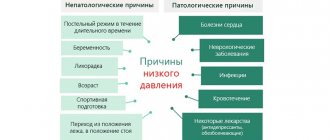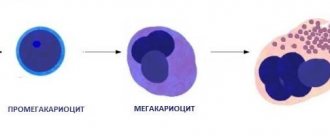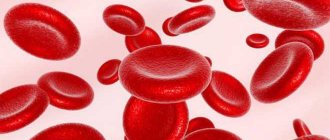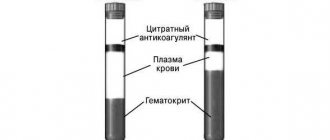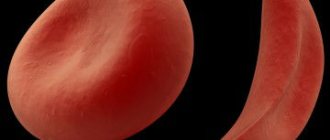Red blood cell distribution index (RDW) is a very important factor during a complete blood count. This indicator shows the size and shape of red blood cells.
Red blood cells perform the transport function, thereby assisting in the penetration of oxygen into all tissues and organs and at the same time taking away toxins and carbon dioxide accumulated in the cells. In their normal state, red blood cells are approximately the same size, which allows them to quickly stick together, forming blood clots.
The indicator of red blood cells in the blood may reflect the presence of pathological processes in the body, especially if the sizes of these cells vary significantly. Next, we will talk about in what situations the erythrocyte distribution index decreases, how this manifests itself and what it indicates.
Reduced RDW: norm and pathology
A person in good health has red blood cells of the same shape, density and color. In case of deviation, especially in the presence of autoimmune diseases or oncology, the failure occurs at the level of microcells, when young cells do not receive a certain number of components, which, in fact, inhibits their performance. Thus, anemia occurs - a pathology during which the body does not receive the required amount of oxygen, in other words, the metabolic function in red blood cells is disrupted.
Purpose of the analysis
The erythrocyte index is included in the UAC. The attending physician can purposefully send a patient to donate blood if the following ailments are suspected:
- oncological pathologies;
- iron deficiency anemia;
- diabetes mellitus;
- liver damage.
Diagnosis of the erythrocyte count is indicated for the following symptoms:
- hereditary predisposition to thalassemia;
- lack of iron in the body;
- weakness, dizziness, hyperhidrosis and other signs of anemia;
- infectious diseases with a long course;
- profuse blood loss.
With pathologies of the form, blood cells cannot perform their main function - to carry oxygen to organs and remove waste products. RDW shows the percentage of red blood cells with a changed shape.
What does RDW mean in a blood test?
During a general blood test, the erythrocyte distribution index is determined. If the presence of a specific disease is suspected, a blood test is prescribed to determine only this indicator.
Most often, the width of the distribution of red blood cells by volume is determined together with the MCV indicator. This is the average volume of red blood cells. This happens because these indices (in quantity and volume) are closely related to each other and help in determining the type of anemia.
It happens that the erythrocyte distribution index is reduced. What does it mean? The thing is that for a qualitative judgment about the state of red blood cells, not only their concentration in the blood is important, but also their shape. An increased distribution of red blood cells is observed in 1 out of 10,000 cases, but if the RDW index is reduced, which is much less common, we are talking about the presence of serious problems in the human body.
A blood test to determine the erythrocyte distribution index can be carried out both during medical examinations (routinely) and as prescribed, if there are suspicions of any abnormalities in the hematopoietic function. The analysis is required before surgery, during pregnancy and in childhood.
Lower RDW
Situations where the RDW indicator is reduced are rare. A deviation from the norm to a lesser extent indicates the development of dangerous diseases and pathological processes in the body that require diagnosis and immediate treatment.
Why is this happening
The resulting value is below normal means that red blood cells lose their function due to some congenital and acquired diseases. The main reasons why a reduced CV occurs in a blood test:
- Profuse bleeding due to injuries or wounds. Bleeding in the uterine cavity or stomach poses a threat to health, and in some cases, life.
- Previous surgical interventions, during which resection of an internal organ was performed.
- Disturbances in metabolic processes, as a result of which food entering the body is poorly digested and remains in the stomach, where it ferments, thereby provoking a purulent process.
- Changes in hormonal levels - this factor is typical for women.
- Low concentration of vitamins and iron.
- Blood diseases characterized by the loss of red blood cells of their functions.
- Oncological neoplasms, mainly tumors of the lungs and brain.
- Pathologies of an autoimmune nature, as a result of which new red blood cells do not receive enough important components, which affects their parameters and functionality.
Important information: What does it mean to have a reduced average red blood cell volume in a child?
The cause of low RDW may be anemia - microcytic hypochromic anemia. In this pathological process, red blood cells have an irregular shape, differ in size and quickly die due to the fact that such blood cells do not represent biological value in the body.
If there is a suspicion that the test result was false positive, the blood will have to be taken again, carefully following the doctor’s recommendations. Factors such as smoking before taking the test, excessive psycho-emotional arousal, and eating food immediately before taking biological material can affect the result of the analysis.
Taking certain medications can also cause a false positive result. Therefore, if a patient is forced to constantly take medications for medical reasons, the laboratory assistant must be informed about this.
How it manifests itself
Low RDW levels are manifested by:
- constant feeling of fatigue;
- lethargy and apathy, drowsiness;
- rapid fatigue even without physical activity;
- frequent attacks of dizziness;
- decreased degree of performance;
- shortness of breath;
- dry cough;
- increased blood pressure;
- rapid heartbeat.
All these signs arise due to disturbances in biological processes. Red blood cells become much smaller in size, which is why they cannot fully perform their functions. Due to their insufficient size, red blood cells cannot deliver enough oxygen to cells and soft tissues. First of all, the central nervous system suffers from this, which, due to a lack of oxygen, cannot fully transmit impulses along the nerve fibers.
If RDW is reduced in a blood test in a 3-month-old baby, this sign may indicate congenital blood diseases. If the indicator deviates from the norm to a lesser extent, first of all it is necessary to exclude a diagnostic error by retaking the analysis. If a repeat analysis again shows an abnormality, it is important to determine the cause, especially to pay attention to possible oncological neoplasms, most often accompanied by a low level of RDW.
Important information: What does a general blood test with leukocyte formula show (decoding)
What to do
An underestimation of red blood cells in the blood is a rare phenomenon, but it signals dangerous diseases and pathological processes that can occur in a latent form until some point and do not have a pronounced symptomatic picture.
There is no single scheme of measures that can be used to increase the level of red blood cells. In order for RDW to be brought to normal levels, it is necessary to determine the cause of the deviations and eliminate it. Given the wide range of causes, therapy is selected individually.
Prevention
Cases where a low RDW result turns out to be only a diagnostic error occur more often than situations where severe illnesses lead to discrepancies with the norm. To avoid a false result, it is necessary to follow all recommendations regarding preparation for the process of collecting venous blood for analysis.
Low red blood cell distribution is a fairly rare phenomenon. It is difficult to prevent the occurrence of this pathological symptom. But some preventive measures will help, if you do not maintain health, then identify the disease in a timely manner and treat it at an early stage of development, avoiding complications.
Prevention of low RDW levels is a set of measures that help maintain good health and prevent the development of many diseases. Such measures include:
- A proper, balanced diet, including foods enriched with vitamins and minerals.
- Fractional meals so as not to put a strain on the organs of the digestive system.
- Maintaining an active lifestyle. It is necessary not only to exercise regularly, but also to take walks in the fresh air, which have a positive effect on the circulatory system and the heart muscle.
- Regular preventive examination.
Even if no symptoms bother you, it is important to undergo a medical examination and laboratory tests at least once a year. There are diseases that last for a long time without a pronounced symptomatic picture. They can be detected in the initial stages only through timely and regular blood tests.
Why is it necessary to do an RDW analysis?
It was already mentioned above that the index of distribution of red blood cells in the blood makes it possible to conduct a qualitative assessment of the composition of red blood cells, taking into account their size.
But why is this necessary? The thing is that these cells are very similar to each other, which gives them the opportunity to replace each other or form blastulas. An increase in cell size entails an increased need for nutrition and, in addition, this means that their life expectancy is reduced. All this directly affects the overall indicator of red blood cells in the blood and the human condition.
When a large number of red blood cells die, iron is released and more bilirubin becomes available, which puts increased stress on the liver, and as a result, it cannot process these substances.
The RDW index is directly related to the pathological process, during which the dimensions of erythrocytes change (anisocytosis). This condition is a complex chemical process that causes all blood cells to suffer.
How is it calculated?
The RDW indicator is calculated as a percentage, the norm of which is considered to be the limit from 11.5 to 14.8. The red blood cell distribution index is determined using a mathematical equation that represents the ratio of modified red blood cells to their total mass.
Nowadays, laboratories use computer technologies that make it possible to calculate the percentage of deviation from the established norm. The calculation results are presented in the form of a histogram depicting a curve that indicates probable changes in the dimensions of red blood cells.
RDW calculation methods and units
Depending on laboratory equipment, red blood cell distribution width can be calculated as coefficient of variation (RDW-CV) or standard deviation (RDW-SD).
It is important to understand that when testing the width of the distribution of red blood cells, it is not the actual width or diameter of individual red blood cells that is measured, but the width of the distribution curve of red blood cells (histogram), which is produced by the blood analyzer.
RDW-CV shows how much the red blood cell volume differs from the average value.
RDW-CV is calculated based on the width of the distribution curve as well as the average cell size. The calculation formula is as follows:
RDW-CV = (1 SD/MCV) * 100
SD – standard deviation of red blood cell sizes
The indicator calculated in this way is usually denoted as a percentage (%).
RDW-CV is directly dependent on MCV, so may not always reflect actual changes in red blood cell size. For example, if most red blood cells are small (as in microcytosis), then the RDW-CV will remain within the normal range.
RDW-SD is a direct measurement of the histogram width of the red blood cell size distribution in femtoliters (fL), which is measured by calculating the histogram width at the 20% height level.
Because RDW-SD shows the actual difference between maximum and minimum red cell volume and is independent of MCV, this index more accurately reflects changes in red cell size.
Normal indicators
The norms of the erythrocyte distribution index depend on gender, age and the presence of certain conditions that occur in the human body. For children under one year of age, the normal rate is 11.5-18.7%. At one year of age and older, the values tend to the generally accepted norm of 11.5-14.5%.
For the female half of humanity, the upper limit shifts to 15.5%, since their hormonal levels change too often: during pregnancy, lactation, taking oral contraceptives, menopause.
For analysis, blood is taken on an empty stomach in the morning (before 9 am). It is very important that before this procedure the person does not take any medications and is in a balanced internal state.
Raising RDW
The RDW level can be elevated in some situations. The most common cause of this pathology is iron deficiency anemia. The indicator can change at different stages of pathology development, which is clearly reflected in the histogram of red blood cells:
- The initial stage of anemia development is characterized by normal indices, but hemoglobin will be greatly reduced. This is the result of healthy functioning of the spinal cord.
- The next stage of development in the histogram will show an increase in RDW. When there are problems with hemoglobin, indicators such as the average concentration and content of hemoglobin in a blood cell and the average volume of red cells decrease.
When treating IDA, it is necessary to normalize the level of concentration of iron-containing protein and its characteristics in the human blood.
RDW and its varieties
What is RDW? The abbreviation stands for Red Cell Distriburion Width. This is one of the general clinical blood test indices, indicating the distribution of red blood cells by volume. By deciphering the index readings, the laboratory technician identifies the presence of red blood cells, which vary in shape and size.
The task of red blood cells is to transport hemoglobin along with oxygen molecules. Successful functioning depends on the shape of the cell - a biconvex disk. The change in volume is called anisocytosis.
There are two varieties of RDW:
- rdw-cv - shows the severity of anisocytosis;
- rdv-sd - indicates the difference between the sizes of red blood cells.
RDW has a direct correlation with another UAC indicator - MCV. MCV index is the average volume of the red cell.
What do the reduced numbers mean?
Patients often ask what this means: “red blood cell distribution index is reduced.” Since the erythrocyte distribution index cannot be assessed without a volume indicator, it is necessary to familiarize yourself with all the options for underestimated indicators and their relationship:
- RDW is low and MCV is below average - indicating problems with the spleen and liver.
- RDW is lowered, and MCV is higher than the normal level - indicates the presence of oncological pathologies, mainly the development of metastases in the bone marrow.
The fact that the erythrocyte distribution index RDW sd is reduced, from a biological point of view, cannot, in principle, be observed. For this reason, most often the patient is offered to donate blood again, observing the following conditions:
- stop smoking and drinking alcohol for 24 hours before blood sampling;
- do not take any medications before the analysis;
- Avoid eating smoked and salty foods the day before.
In the case when the erythrocyte distribution index RDW sd is indeed reduced, which is necessarily confirmed by deviations from the norm in the MCV indicator, then this indicates the occurrence of certain pathologies. These include:
- Hypochromic microcytic anemia - sometimes also called anemia. A condition in which irregularly shaped red blood cells die because they have no biological value in the body.
- Malignant tumors - usually in this case we are talking about mastopathy, bone marrow and lung cancer.
- Hemolysis of red blood cells is a process during which red blood cells die without reaching their target. As a result, active hemoglobin is released.
Red blood cell distribution width (RDW)
Synonyms: Red cell distribution width, RDW-SD (standard deviation), RDW-CV (coefficient of variation), Erythrocyte Distribution Width
Providing all systems and organs with oxygen is one of the most important processes in the human body. After inhalation, the air is directed to the lungs, where the work of blood cells - red blood cells - begins. They transport oxygen to every cell of our body, and also take part in the reverse process - they carry carbon dioxide to the lungs. Malfunctions of red blood cells often lead to the appearance of serious pathologies.
To assess the morphology (appearance) of red blood cells, red blood cell indices are used:
Red blood cell volume distribution width (RDW) measures the deviation of red blood cell volume from normal, rather than the actual size of individual cells. In other words, the difference between the largest and smallest red blood cells is determined.
Causes
So, the erythrocyte distribution index is reduced - what does this mean? There are several reasons that can reduce the RDW indicator:
- Acute blood loss due to injuries and pathological bleeding.
- Frequent operations.
- A metabolic disorder during which the food consumed is not completely digested.
- Hormonal imbalance, which most often occurs in women.
- Deficiency of B vitamins and iron in the body.
- Blood diseases characterized by rapid destructive processes.
What measures to take?
What to do when the red blood cell distribution index is low?
A highly qualified doctor during a consultation will most likely ask the patient to take the test again, because the RDW indicator is almost never underestimated. Because this suggests that all cells are ideal in their parameters, but this cannot happen in principle. If the indicator is confirmed by repeated analysis, then a full examination of the body’s condition is carried out, paying special attention to oncological examinations.
Preventive measures
You can prevent a reduced RDW by following these simple rules:
- The diet should be balanced, which includes plenty of fresh fruits, lean meats and vegetables.
- It is recommended to breathe fresh air as often as possible.
- An active lifestyle will help prevent a decrease in the RDW index.
- It is very important not to skip routine medical examinations, during which most often serious deviations from the norm are detected that do not have external symptoms.
As a result, we learned that the red blood cell distribution index reflects their dimensions relative to each other and makes it possible to learn about their biological value. A decrease in RDW is very rare, but if the erythrocyte distribution index is decreased, this means that various pathologies may be present.
The index is calculated based on the results of a general blood test, but can only be fully valid in conjunction with the MCV indicator, since they are closely interrelated.


